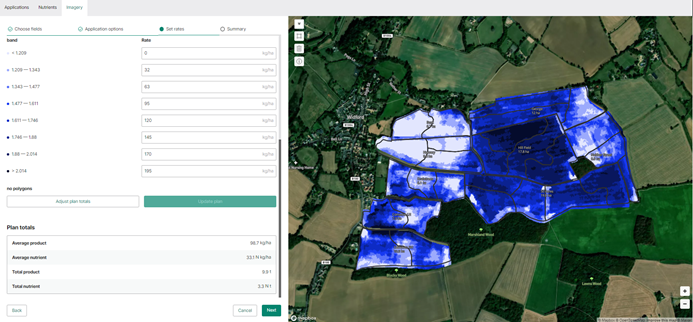Feeding for yield with Variable Rate Nitrogen
13
JULY, 2021
Blog
When we think of VR nitrogen we generally think about its use to promote tiller numbers at the N1 timing. Traditionally this tends to be with the view that loading up poor areas of crop with extra nitrogen will encourage smaller biomass crops to tiller more and compensate for a lower winter emergence plant stand. But where do we draw the line? At what point do we accept the crop variation we have and react accordingly? Is there an alternative Nitrogen strategy that we can adopt?
Trials, such as Agrii’s Digital Technology Farms (DTF’s), do show a response in tiller numbers using this approach, but as with all nitrogen applications we are somewhat at the will of the gods with the weather. The past few springs have given us a mixture of drought and fluctuating soil temperatures, all making nitrogen timing difficult to predict. And once applied Nitrogen usage efficiency is questionable.
Infield variation is not always apparent at the early N1 timing and dependant on the weather conditions and soil type recovery of thinner crops is not always possible. Likewise good areas of field coming out of winter can then go backwards if soils drought due to lack of rainfall in march/April.
To muddy the waters further the SFI and ELMS look to have an increasing focus nutrient management and responsible use of products, meaning we may have to not only justify applications but also show that we are applying product where the crop requirement is needed. Therefore are we right in justifying higher nitrogen applications on lower biomass areas of crop with the view that we may have an increase in tiller numbers? VR inputs such as Nitrogen allow farmers to show that they are indeed being responsible with their use of product, whilst showing a return on their investment either through yield or product saved.
The DTF trials along with RHIZA are set out this year to help look for answers with this question. But there is some light at the end of the tunnel in the form of LiquiSafe, a Nitrogen inhibitor. RHIZA have been working with Farmers this year in optimising their investment with LiquiSafe application with yield targeted Final nitrogen maps.
Farmers are applying up to 70% of the total Nitrogen at the N1 timing are reaping the rewards of front end loading early N and sustained nitrogen supply even when the weather turned dry. The remaining nitrogen was the applied at the usual N3 timing as a VR application feeding for yield only. Generally by this time growers/agronomists will have a good feel on crop potential, with a bit of luck the weather has shown its hand and decisions can be made on Nitrogen strategy with a little more knowledge to play with.
RHIZA’s NDVi imagery is used to show variation in field, this is then checked by either that farmer or agronomist, who can make an assessment on whether different parts of the field have the potential for yield or not. A VR application maps can then be produced to apply the remaining 30% of the Nitrogen.
Using LiquiSafe and front-end loading the nitrogen allows us to give all parts of the field the best chance to maximise its potential but also hold back an amount to apply just to the areas that have the potential to exceed others. For example a WW crop with a 250Kg/Ha nitrogen requirement will have received 175Kg/Ha as its first application. The remaining 75Kg’s can then be applied according to Biomass imagery. There may well be areas of the field where the crop will not have the potential to yield any more and therefore you may be turning off the sprayer in these areas.
RHIZA Case Study

Variable rate calculations for nitrogen application in the Contour platform.
The Contour platform allow for quick and easy planning from imagery. Nitrogen plans can be generated, reports & GPS files produced in minuets. The image based planning tool takes Satellite imagery rate parameters set by the user and creates a VR map. Polygons for no spread areas can be added.
The above customer had planned for his last Nitrogen application to be 195Kg/Ha of Origin 33.5, which would have delivered the 65Kg’s remainder of his total Nitrogen for this WW crop. It was clear to the agronomist when crop walking that some areas of the field did not have the biomass to support yield and therefore did not justify the extra N application due.
At this point the decision was taken with the RHIZA account manager, farmer and agronomist that a VR application should be made that only fed to the areas of the field that had the potential to yield and therefore would not be wasting Nitrogen where it was not needed. The rates varied from 0kg’s to the 195Kg’s originally recommended.
“Using LiquiSafe and front-end loading the nitrogen allows us to give all parts of the field the best chance to maximise its potential.”
The original flat rate recommendation was for 19.5t of product. The RHIZA VR plan required 9.9t. which lead to a financial saving of £3120 (Nitram @ £325/t) which equated to £26.70/Ha saving (including RHIZA planning costs).
Content supplied by Sam Fordham, RHIZA Head of Technical & Lucy Cottingham, UK Digital Agronomy Development Manager at Agrii.
